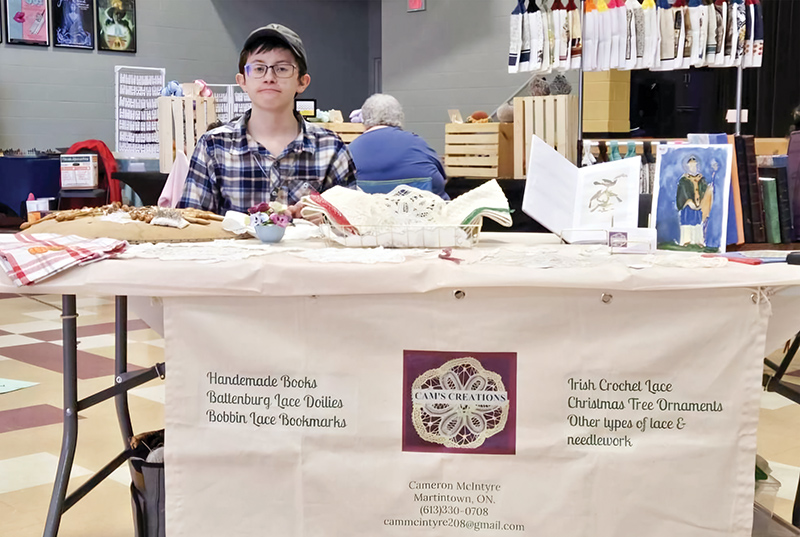Artisans such as Cam preserve the art forms of yesteryear, ensuring they continue to be enjoyed. He is seen at one of the local craft shows with his work. Courtesy Photo
CHESTERVILLE – Lace making has a very long history dating from the 1500’s, with two main types of the creation of lace being needle lace or bobbin lace. Lace is a symbol of power and elegance and has many uses including decorative articles for the home. Historically, both men and women were lacemakers in the different areas of Europe where lace is thought to have originated from.
To make lace there is the need for the artist who creates the designs, a pattern maker who puts the design onto paper and the lace maker who works on the patterns to make the lace. The almost lost art of lacemaking by hand has been given a breath of life by young entrepreneur Cam McIntyre, the owner/operator of Cam’s Creations.
This home-based business sells articles made from lace as well as creating and repairing books. He began making lace in 2020, utilizing eight different types of lace and the following year began making books using traditional methods and materials.
“I started the business when I did a fundraiser for the Stormont County 4-H Beef Club.” said McIntyre. The young entrepreneur had begun making items such as doilies, bookmarks, appliques and Christmas tree ornaments out of lace. It was after the successful fundraiser, the realization that a market for his creations existed, with local craft shows providing a venue for his work.
When visiting the Cam’s Creations booth at a craft show, McIntyre provides the visitor with an informative and interesting historical approach to the almost extinct art of lace making. “I enjoy educating people on the different types of lace and how they are made.” He also has begun creating his own lace patterns and enjoys learning how to create articles using them. McIntyre also creates books for people to use such as notebooks and day planners. He mentioned how he enjoys explaining to craft show visitors how they are made and the “different components of book binding.”
“Finding information on how to make the variety of laces is one, and two finding the materials to make the different laces” are two challenges he has overcome. Learning to make the lace articles and book binding was through watching social media videos or reading books given to him on these subjects. He has also been given some equipment by former lace-makers who are supportive of the craft being carried into the future.
When asked about advice to give to young entrepreneurs, McIntyre mentioned it is important to perceiver and not give up. “Since I sell my crafts mostly at craft shows, I know that there are days that I will sell more than others” he said. While this can be discouraging, the support and encouragement from his family helps. “My family keeps encouraging me to continue to make the crafts that I enjoy and not to stop because I didn’t have good sales that day.” He also mentioned how “lacemaking in general is not a gender-based craft ” and encourages people to not “let the stereotypes impact your interests. If you enjoy it, don’t let anyone stop you.”
McIntyre plans to set up an Instagram account in addition to his Facebook page to help advertise his business as well as setting up an email address and making business cards. He has also entered his crafts in local fairs, winning prizes in the category and enjoys speaking to people about his business.
It is through the work of young entrepreneurs such as McIntyre that artistic textile work from yesteryear will remain an important part of heritage in the future.
If you would like to have a light shined on your business, please contact us at: editor@etceterapublications.ca or call us at 613-448-2321.

Carolyn Thompson Goddard, grew up in Chesterville and attended North Dundas District High School. After completing her BA in Political Science at Carleton University she has worked as a medical secretary and library technician. In 2020 she graduated from Algonquin College with a diploma in Journalism and has been a reporter and column writer for The Chesterville Record for over 10 years.











